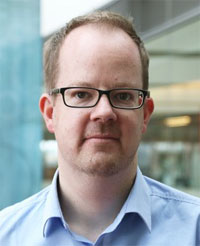About This Webinar
This webinar will discuss a new model for advanced microscopy, based on shareable, modular instruments. This model, called Flamingo, is designed to bridge the gap between biology and technology. Flamingo modules are configurable to a broad range of applications. Employing modularity in the design facilitates reconfiguration, allows easy upgradability, and offers a greater choice of functions. Shareability provides a cost-effective way for labs and institutions to have widespread access to cutting-edge technologies.
The ability to custom-design an instrument around a sample has empowered many research labs to perform experiments that would have been impossible with commercial instruments. However, in order to access cutting-edge microscopy technology, many scientists must visit an engineer’s lab or a facility that offers the technology. Because living biological samples can die or otherwise degrade in transit, experiments can be severely compromised when the scientist must travel to a shared microscopy resource. Flamingo will give scientists access to the newest microscopy technologies, without needing to travel to another site.
Presenter Jan Huisken, a principal investigator at the Morgridge Institute for Research at the University of Wisconsin-Madison and one of the founders of light-sheet microscopy, will begin with a history of this versatile, simple technique to obtain optical sectioning deep inside biological specimens. He will discuss the benefits of light-sheet microscopy, such as low phototoxicity and high-speed image acquisition, and will describe the development of Flamingo and how the Flamingo model for advanced light-sheet microscopy could be used to advance the work of labs worldwide.
About the presenter:

Jan Huisken, Ph.D., is a principal investigator and director of medical engineering at the Morgridge Institute for Research. He is a professor at the University of Wisconsin-Madison and recipient of the Royal Microscopy Society Medal for Light Microscopy. Huisken studied physics in Göttingen and Heidelberg, Germany, and has a background in 3D fluorescence microscopy, optical trapping and manipulation techniques, developmental biology, and cardiac morphogenesis and function in zebrafish. He received his Ph.D. from the European Molecular Biology Laboratory (EMBL) Heidelberg, where he pioneered multidimensional light-sheet microscopy as well as selective plane illumination microscopy, or SPIM, in the lab of Ernst Stelzer.
To participate in one of the first applications of light-sheet microscopy, Huisken moved to the lab of Didier Stainier at the University of California, San Francisco, as a cross-disciplinary Human Frontier Science Program (HFSP) postdoctoral fellow to study cardiovascular morphogenesis and function in zebrafish. From 2010 until 2016 Huisken was an independent group leader at the Max Planck Institute for Molecular Cell Biology and Genetics in Dresden, Germany.
Who should attend:
This webinar is for anyone in the scientific community who uses or oversees the use of microscopy tools. Lab managers, researchers, investigators, educators, students, and others will benefit from this overview of light-sheet microscopy and this model for making state-of-the-art microscopy tools and technology available to labs everywhere. Optical designers and engineers and others involved in the development of microscopy tools will also benefit.
Read more about Flamingo in this University of Wisconsin-Madison article:
High-Powered Microscopy Coming to a Scientist Near You, by Brian Mattmiller (June 21, 2018).
This webinar is sponsored by
Applied Scientific Instrumentation Inc. (ASI). ASI creates solutions. Whether you need help with precise and stable positioning for superresolution microscopy, a custom modifiable microscope tailored for your application, or a complete light sheet microscope system, ASI has the proven products, people, and partners to provide well-engineered solutions for all your applications.